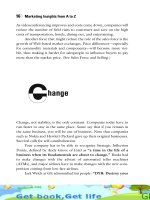picasso life from birth to death
Bạn đang xem bản rút gọn của tài liệu. Xem và tải ngay bản đầy đủ của tài liệu tại đây (39.93 KB, 2 trang )
The Early Life and Career of Pablo Ruiz y Picasso
According to Ariane Ruskin Batterberry, Pablo Ruiz y Picasso is considered the most famous
artist of the 20th Century. Picasso always working to improve his artistic skills, he would just sit
alone and paint or sculpt anything that would come to his mind. Picasso worked on many
different styles of art, such as, painting, sculpting, printmaking, ceramics, and scene designs. As
Batterberry brings to our attention, Picasso is said to have lived several artistic lifetimes.
Throughout most of his career Picasso was extremely poor, but this did not stop him from being
great at whatever it was he was doing (34-35,243-244).
Picasso was born on October 25, 1881, in Malaga, Spain (Batterberry,243). When he was young
his family moved to Barcelona (World Book Encyclopedia,448). He liked painting pictures of the
city life around him. In 1896 he entered the school of Fine Arts, where his father was a professor.
Paris was the Center of Art and Literature, he visit the city in 1900, where he fell under the spell
of the artistic atmosphere. He returned later and settled in 1904. He was very poor, but his studio
became a meeting place for many artists Batterberry, 243-244). Picasso had his first exhibition at
the Cafe Quatre Gats in Barcelona. He studied at the Royal Academy of San Fernado in Madrid
for many years (World Book Encyclopedia, 448).
As Ariane Batterberry points out, Picasso painted scenes of the day-to-day life of many poor
people of his neighborhood. He painted several circus pictures, which were mostly for the
amusement of children. He also did paintings in varieties of gray and blue, these were called
"Picasso's Blue Period" (Batterberry, 243). John Kehoe tells us that, Picasso's works were named
by the atmosphere each piece showed. His Blue Period-showed lots of blue colors that were full
of sadness. The Rose Period was a very soft warm optimistic mood. Picasso also experimented
with Cubism, which he picked up from George Braque, a french painter. He used postage stamps
and newspapers which this style of work was known as Collage (135-137).
Picasso was very much influenced by Paul Ciezanne. He tried to show the geometric shapes in
life. Picasso and a friend attempted this and used geometric shapes for the paintings of a band.
This form and style of painting was know as Cubism. He also made several collages by painting
various things using different materials (Batterberry, 243). For 70 years or more his energy burst
through conventional boundaries to discover new releases. Body of works included paintings and
sculpture, they could have very well been the work of a dozen artists. His works were auctioned
for enormous prices, making him extremely wealthy. Picasso quoted several of his works, such as;
Beauty, Art, and Research "I have a horror of people who speak about the beautiful. What is the
beautiful? One must speak of problems in painting! Paintings are but research and experiment. I
never do a painting as a Work of Art. All of them are researches.", Bad Paintings "I like all
paintings. I always look at the paintings-good or bad-in barbershops, furniture stores, provincial
hotels I'm like a drinker who needs wine. As long as it is wine, it doesn't matter which wine.",
Symbolism and Communism "If I paint a hammer and a sickle people may think it is a
representation of Communism, but for me it is only a hammer and sickle. I just want to reproduce
the objects for what they are; not for what they mean." ("Domain of the Arts", 1-2).
Picasso's moods were known to change as often as his lifestyles. His art was extremely valuable
even in his own lifetime, because of the great variety of his styles. After he moved to Spain,
Batterberry explains. Picasso still continued to experiment with painting, as well as sculpture,
printmaking, ceramics, and collage (244). John Kehoe provides us with the information that, in
the late 1920's Picasso turned toward a flat, cubist-related style. In the 1930's however paintings
became militant and political.
Guernica (1937) masterpiece from this time period reflects the terror of the bombing of the town
of Guernica during Spanish Civil War. After WWII his works became very gentle, because of he
moods that were around him. Picasso worked the rest of his life on historical styles of art, most
were reproductions of other artists works (200-202). As he often did, Picasso also quoted many of
his paintings and works done in his later years by saying "If everyone would paint, political
re-education would be unnecessary.", "No, painting is not made to decorate apartments, its and
offensive and defensive weapon against the enemy.", "I paint the way someone bites his
fingernails; for me, painting so a bad habit because I don't know nor can I do anything else.", and,
"Today we haven't the heart to expel the painters and poets from society because we refuse to
admit to ourselves that there is any danger in keeping them in our midst." ("Domain of the Arts",
1-2).
Picasso, Pablo died April 8, 1973. Titan of 20th Century art till death at his hill top mansion in
Notre Dame de Vie. His death at 91 was attributed to pulmonary edema fluid in the lungs. He
rarely left his 17 acre estate, which was covered by barbed wire. Besides his wife he left behind
four children, all from previous wives and mistresses. ("Domain of the Arts, 1).
Works Cited
Batterberry, Ariane Ruskin. "Picasso, Pablo." The New Book of Nowledge, Vol. 15, 1986 ed.,
pp. 243-244.
Kehoe, John. Life File. New York: Hearst, and Company, 1987.
"Picasso, Domain of the Arts." (No publishing information given).
"Picasso." World Book Encylopedia, Vol 15, 1995 ed., pp. 448-449.
"Twentieth-Century Art." Los Angeles County Museum of Art









